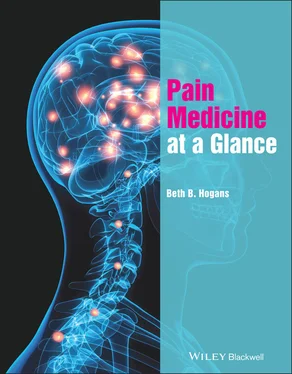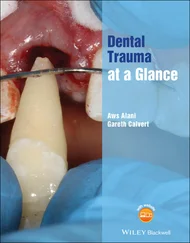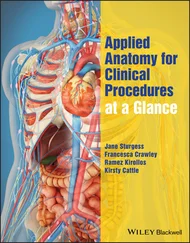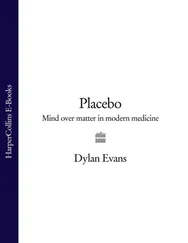Neuropathic painarises from disease, damage, or dysfunctionof the nervous system. There are many nervous system conditions manifesting pain including multiple sclerosis, post‐herpetic neuralgia, myelopathy, nerve root compression, and peripheral neuropathy. In these cases, pain is driven by abnormal signalingarising from the pain‐sensing system itself (Devor 2013). This pain can be difficult to treat if the underlying abnormality is not rectifiable. Neuropathic pain is not highly responsive to NSAIDs, and generally prescription medications are required. Multiple treatment options are available. Pain‐active anticonvulsants such as gabapentin or pregabalin, or pain‐active anti‐depressants, such as amitriptyline or duloxetine can provide relief, Chapter 19. Although these neuromodulating medicationsare not universally effective, substantial pain relief may follow when careful attention is applied to titrating medication and addressing the underlying condition. In neuropathic pain, disease modifying therapies are especially valuable. Some forms of neuropathic pain are treatment resistant.
The presence of abnormal pain responses during clinical examination aid in distinguishing nociceptive, inflammatory, and neuropathic pain. Abnormal pain signaling is recognized by the presence of allodynia or hyperalgesia. To explain these terms, it's necessary to introduce the stimulus‐response curve. Pain is systematically assessed in clinical and pre‐clinical trials using a stimulus response curve, this is a graph that represents a person's rating of sensory intensity (pain) in response to a certain stimulus ( Figure 3.3). Imagine touching a metal surface of a certain temperature. At room temperature, there is no pain. As the temperature rises, at some point there is a twinge of pain, this is the pain threshold. As temperature increases further, pain ratings increase, usually forming an S‐shaped curve: at high temperatures the pain ratings are already 10 and further increases don't result in more pain. With neuropathic or inflammatory pain, a person will often feel pain at lower temperatures. The experience of pain in response to a normally non‐painful stimulus is called: allodynia. This same person may feel more pain in response to stimuli that were previously painful, this is called hyperalgesia(see Glossary).

Figure 3.3 Stimulus response curve: normal and abnormal pain perception.
In summary, a mechanism‐based classification of pain organizes the clinical approach to the patient with pain and is effective for understanding symptoms, and ultimately planning a diagnostic work up, devising a successful treatment plan, and guiding the patient to effective self‐management.
1 Devor, M. (2013). Neuropathic pain: pathophysiological response of nerves to injury. Chapter 61. In: Wall and Melzack’s Textbook of Pain, 6e (eds. S.B. McMahon, M. Koltzenburg, I. Tracey and D. Turk). Philadelphia, PA: Elsevier Saunders.
2 Ringkamp, M., Raja, S., Campbell, J., and Meyer, R. (2013). Peripheral mechanisms of cutaneous nociception. In: Wall and Melzack’s Textbook of Pain, 6e (eds. M.M. SB, M. Koltzenburg, I. Tracey and D. Turk). Philadelphia, PA: Elsevier Saunders.
4 How prevalent is pain and what are the common forms?
Pain is remarkably prevalent. It is present, at this moment, in millions across the globe. The specifics depend on factors including age, sex, ethnicity, and circumstance, but high pain prevalence is universal ( Figure 4.1). In the U.S., data showed 116 million Americans, over one in three, experiencing pain: whether acute procedural pain, trauma, cancer, headache, low back pain, or other pain conditions (IOM 2011). Remarkably, a vast amount of pain is avoided: today millions of surgical procedures annually are performed with managed paindue to advances in surgical pain management and medication access worldwide ( Chapter 30). Unfortunately, huge challenges persist in pain management as millions experience limited healthcare accessand others struggle against chronic pain‐associated conditions. Here, we explore the challenges.

Figure 4.1 (a) Pain is highly prevalent, present in about 38% of the population. (b) Pain overall demonstrates some female preponderance. (c) Migraine, a common headache condition shows female preponderance, 2 : 1, female : male. (d) Cluster headache has a 2 : 1 male preponderance but is much less prevalent (0.1% lifetime prevalence for cluster headache; 14% lifetime prevalence for migraine).
The common causes of pain are well established and include: headache, low back pain, osteoarthritis, trauma, neuropathy, cancer, and HIV/AIDs primarily (Murphy et al. 2017). Some less common chronic pain conditions, such as CRPS and fibromyalgia, have particularly high healthcare utilization often leading clinicians to overestimate the relevance for education, are described elsewhere ( Chapter 45).
Headacheis highly prevalent worldwide with nearly half (47%) experiencing headaches at least annually. Most headaches are tension type headaches, 40% experience these. Migraines are less common but more disabling; women more affected than men with global lifetime prevalence (F : M) 22% : 10% and current prevalence 14% : 6% (Stovner et al. 2007). Low back pain is highly prevalent in many countries with 30–40% of adults reporting “current” back pain. Osteoarthritisis highly prevalent in older adults with 30% experiencing disabling pain due to arthritis, knee osteoarthritis has been noted as the most common cause of pain‐related impairment globally. Trauma‐related pain, including that related to musculoskeletal injuries is a universal phenomenon with extremely high life‐time prevalence, the extent of impairment from work due to musculoskeletal trauma (including back and sprain injuries) exceeds all other causes. Neuropathyis prevalent in older adults with 20% over age 75 impacted. Cancer pain is a global burden with 50% of advanced cancer patients reporting pain, access to pain medication is a major determinant in cancer‐related suffering. HIV/AIDS is associated with pain. Recognizing pain cause or basic mechanism is important in clinical practice as the choice of treatment depends on the source of pain and the potential risks of treatment vary with disease context.
Pain prevalence increases with agewith 50% of older adults experiencing chronic pain. Much of this pain is due to degenerative joint disease: lumbosacral DJD, knee and hip osteoarthritis. Peripheral neuropathy increases with age. Shingles, a painful eruption of herpes zoster, can cause post‐herpetic neuralgia. The incidence of shingles is reduced by 50% with vaccination, CDC recommends vaccination for those age 60 and over.
Certain populations are especially prone to chronic pain, veterans, those of lower socioeconomic status, and former athletes. Patients with cancerare very likely to experience inadequately controlled pain.
The prevalence of pain varies somewhat between ethnic groups in the United States. Although pain thresholds (minimum detectable pain) are similar across ethnic groups, Caucasians generally demonstrate higher experimental pain tolerance than do African Americans, Hispanic, and Asian populations, the reasons are unknown (Kim et al. 2017). Important disparitiesin access to care and impacts on clinical decision‐making influence outcomes. These factors generally contribute to higher levels of untreated pain in minority populations (Campbell and Edwards 2012). There is no evidence that people of color experience less pain and proper pain assessment is essential for all patients.
Читать дальше













